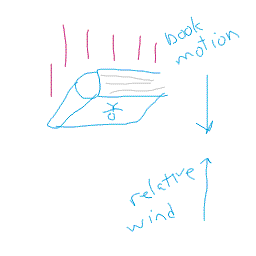
Now lets change the example a little bit. Take a hardcover book in your hand, and drop it. Think about a little person glued to the bottom of the book. As the book falls, he will feel the wind seem to come directly up at him from the ground. Again, this is relative wind due to the motion of the book:

Instead of dropping the book, let's slide it along a table sideways. The table is there to prevent it from falling, so the only motion will be sideways motion. For this exercise, we let the little guy stand on top so he won't be squished:
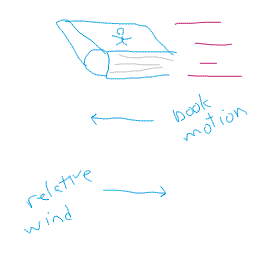
What if we remove the table, throw the book sideways, allowing it to also fall toward the ground. It will have two components of motion, one horizontal and one vertical, like this:
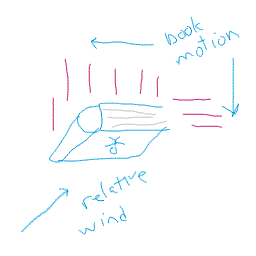
Note that the relative wind is the combination of the horizontal and vertical motions. To the poor little guy about to be squished again, it seems to be coming at him from an angle, somewhere between the vertical and horizontal. Now let's use a tiny bit of math. If we draw the blue arrows to represent the two components of motion, horizontal and vertical, and then we extend red lines down from the top arrowhead and to the left from the bottom arrowhead until they meet, we can then draw the green line back to the origin of the two vectors. The green line is a vector which will show us the direction the relative wind is coming at the little guy on the book:

Notice that the two blue lines are about the same length, and that the angle ends up being about 45 degrees. That's not by chance. Let's take a look at what happens if we make the horizontal component of motion be twice as fast as the vertical component:
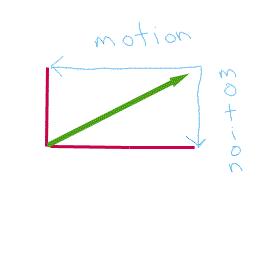
Notice how the angle has changed! Because the horizontal component is larger, the angle seems to be more horizontal than vertical. We can calculate the angle this way, as long as we know the horizontal component and vertical component of motion.
Okay, what's all this got to do with flapping? If it's not already obvious, the book represents the rotor blade. Let's see a picture of a rotor blade that is spinning, but not flapping:
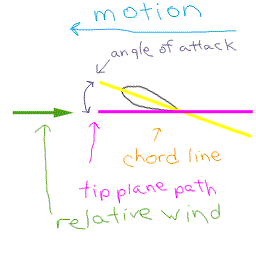
This is sort of a complex diagram, but lets take it part by part. The blue line shows the motion of the rotor blade, moving forward due to rotation. The green line shows the relative wind. Since there is only a horizontal component to motion right now, the green line is horizontal. The pink line labeled tip plane path shows the orientation of the rotor disk. It's just another line showing the horizontal motion of the rotor blade. The yellow line which is labeled chord line can just be thought of the direction the airfoil is facing (but not necessarilly moving). In the case of this diagram, this would all be consistent with a helicopter at hover: the chord line is tilted because the pilot has raised the collective control, thereby tilting the blade up from the horizontal. Angle of attack is defined as the angle between the relative wind and the chord line. That is shown by the purple line.
In the next figure, we've added some vertical motion to the rotor blade:

The way I've drawn this is on top to show the two components of motion of the rotor blade. Note that the blade is flapping up. I've copied the blue lines of motion down by the airfoil, and used the red lines to show where we would extend the blue lines to. Then I drew the green relative wind line from this point back to the origin. There are a few interesting things to notice now.
First of all, remember that the relative wind is equal and opposite to the direction the object is going, so the green relative wind line also gives us an idea of the path of the blade. Clearly it is moving forward and up. The important thing to notice, however, is that the angle between the relative wind and the chord line is now cut about in half. In this case, the lift would also be cut in half. If this is not clear to you, lets see the same diagram, but rotated so that the relative wind is horizontal to us:
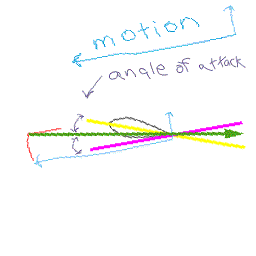
It should be clear that the angle of attack in this picture is much smaller than the diagram without flapping.
One final key to all this is, what makes the blade flap up? The answer is very simple: it's the excess lift. Remember that at a hover, the blade angle is where the forces of lift and centrifugal force balance out. If we increase the lift (because of the excess airspeed on the advancing blade) and the centrifugal force stays the same, the extra lift will cause the blade to flap up to a higher position until lift and centrifugal forces are once again in balance.